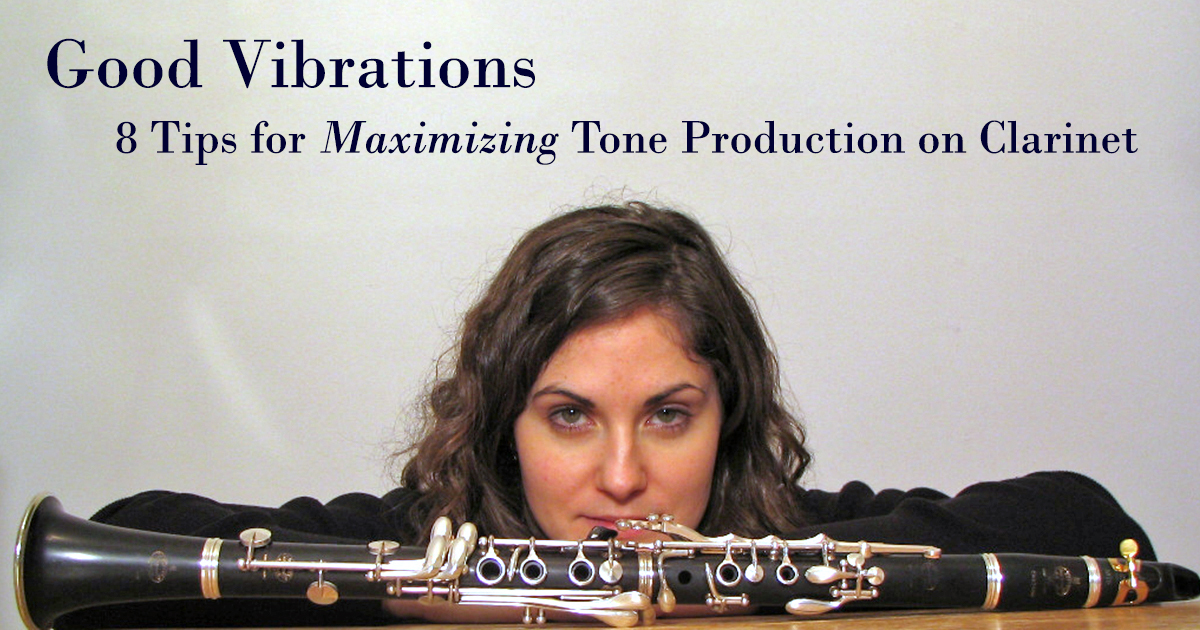Good Vibrations: 8 Tips for Maximizing Sound Production on Clarinet
By: Dr. Levana Cohen
Date Posted: February 15, 2017

When trying to optimize one’s sound production on the clarinet it is important to understand how the sound is produced. Sound on the clarinet is achieved with the vibration of the reed against the mouthpiece. If the vibration of the reed is obstructed or minimized in even the most subtle of ways one’s sound production will also be minimized or constricted.
1. Blow more air into the instrument
- This is the number one reason most clarinetists do not play with a big enough sound.
2. Take in enough mouthpiece
- As a reminder for where one should place their top teeth on the mouthpiece, the player can experiment with placing a piece of electrical tape on the mouthpiece and slide their upper teeth down to the tape mark. I like my top teeth to be about a half of an inch from the tip of the mouthpiece.
- To find where the bottom teeth should go, place a business card in between the reed and the mouthpiece and draw a line on your reed with a pencil where the business card stops.[i]
3. Don't bite so hard
- Try using a "double lip" embouchure by tucking the upper lip over the top teeth. If it hurts the upper lip to play, then the player is biting too hard.
4. Experiment with the angle of your instrument
- Holding the instrument too close or too far from one's body will limit the vibration of the reed.
- Holding the instrument at about 45 degrees away from the body seems to be a good distance for most people.
5. Play with a hard or soft enough reed
- If the reed is warped and it's not resting flat against the mouthpiece facing, try taking it off and rubbing it on top of a piece of paper on a flat, clean surface to "iron it out."
- One could also simply try massaging the reed on the vamp in between the heart and the shoulder. Be careful, damage to the reed can occur if one rubs too hard too close to the tip of the reed.
6. Play with a good embouchure
- No blowfish faces
- The lips should press towards the mouthpiece and the chin/nose should pull away (say EUWW to achieve this)
- Get "taller" between your nose and the tip of your chin - the chin should be flat and pointy
- The tongue should rest on the top teeth so there is only a small opening at the tip for the air to escape as if you were saying "thee"
- Play with cold, not warm air
- Say SHH through your instrument as you play as if you were telling someone to be quiet.
- Pay close attention to keeping a flat chin
- The lower lip should be smooth and stretched out toward the corners of your mouth
Remember: "If the vibration of the reed is obstructed or minimized in even the most subtle of ways one’s sound production will also be minimized or constricted." - Levana Cohen
7. Do not use a heavy tongue when starting or stopping the sound (tonguing)
- Say tee, tee, tee or thee, thee, thee to start or stop the vibration of the reed.
8. Allow the throat to be in its natural, relaxed position
- Inhale through the barrel of the instrument to see how this feels
[i]Julianne Kirk-Doyle of SUNY Potsdam
Seattle born clarinetist, Levana Cohen is an avid performer and music educator. Her performances have taken her to some of the most prestigious concert halls including, Carnegie Hall, Jazz at Lincoln Center's Rose hall, the Koussevitzky Music Shed and Ozawa hall of Tanglewood, Benaroya Hall, Symphony Space, The DiMenna Center, Flushing Town Hall and the 92ndY sharing the stage and performing with such artists as Frank Morelli, William Purvis, Steven Taylor, Shlomo Mintz and the Emerson String Quartet to name a few. Levana's life as a NY based freelance musician has made her into an extremely versatile musician performing and teaching in a multitude of different genres. In performance, these genres include the ballet, pit orchestra, opera, chamber music (both in the concert hall and for house parties), studio musician (recording for TV and radio), and the occasional concerto. Currently, Levana perform as the Principal Clarinetist for the Astoria Symphony Orchestra and appears at universities nation-wide leading masterclasses, clinics and performing recitals and concertos.
As a committed and devoted music educator, Dr. Cohen enjoys teaching students of all ages. She is the clarinet professor and teaches the Woodwind Method class at Long Island University, C.W. Post campus. She also serves as the Clarinet Instructor at Suffolk County Community College, and operates her own private teaching studio in Port Washington NY. Apart from helping her students find their true, unique voice on their instrument, one of her highest priorities at the college level is to prepare her students for successful careers in music. Dr. Cohen is a Vandoren Regional Artist and through this program gives free clinics to music programs across Long Island. Additionally, Levana is a Woodwind Specialist and coach with the Metropolitan Youth Orchestras of New York, a chamber music coach for Stony Brook University, and is the director of the Port Washington Clarinet Choir.
Levana holds both a Master of Music degree and a Doctorate of Musical Arts degree from Stony Brook University under the tutelage of Daniel Gilbert. She performs on Buffet Tosca clarinets and uses Vandoren mouthpiece, ligature and reed products.